ராதே கிருஷ்ணா 14-06-2017
DEFINITION OF BHAKTI Bhakti is profound love for God coupled with knowledge of the majesty and magnificence of Lord Shree Krishna. - Shikshapatri Shlok 103 Narada Muni - The Acharya of Bhakti has written that Bhakti is the fifth and best ‘Purushartha’ or goal of life. It is beyond Dharma, Artha, Kama and Moksha BHAKTI There are basically two major types of Bhakti: Falaroopa - A leaf, flower, fruits or water is gladly accepted by me if offered with devotion and level of mind as explained in Gita. Sadhanroopa – This is again split into nine type known as “Navadha Bhakti” as described in Satsangi Jeevan, 1st Prakaran, 36th Adhyaay. NAVDHA BHAKTI Shravan Kirtan Smaran Archan Paadasevan Vandan Dasatva Sakha Atmanivedan SHRAVAN Is hearing of Lord's Lilas. Sravana includes hearing of God's virtues, glories, sports and stories connected with His divine Name and Form. The devotee gets absorbed in the hearing of Divine stories and his mind merges in the thought of divinity; It cannot think of undivine things. The mind loses, as it were, its charm for the world. The devotee remembers God only even in dream. The devotee should sit before a learned teacher who is a great saint and hear Divine stories. He should hear them with a sincere heart devoid of the sense of criticism or faultfinding. The devotee should try his best to live in the ideals preached in the scriptures. One cannot attain SravanaBhakti without the company of saints or wise men. Mere reading for oneself is not of much use. Doubts will crop up. They cannot be solved by oneself easily. An experienced man is necessary to instruct the devotee in the right path. King Parikshit attained Liberation through Sravana. He heard the glories of God from Suka Maharishi. His heart was purified and so attained the Abode of Lord Vishnu in Vaikuntha. He became liberated and enjoyed the Supreme Bliss. KIRTAN Is singing of Lord Glories and praises of god The devotee is thrilled with Divine Emotion. He loses himself in the love of God. He gets horripilation in the body due to extreme love for God. He weeps in the middle when thinking of the glory of God. His voice becomes choked, and he flies into a state of Divine Bhava. The devotee is ever engaged in Japa of the Lord's Name and in describing His glories to one and all. Wherever he goes he begins to sing and praise God. The devotee requests all to join his Kirtana. He sings and dances in ecstasy. He makes others also dance. In Kalyug, the way to attain moksha is kirtan bhakti Sukadeva Goswami(spoke the Bhagavatam to Maharaja Pariksit) SMARAN Is remembrance of the Lord at all times and Chanting “Swaminarayan”. This is unbroken memory of the Name and Form of the Lord. The mind does not think of any object of the world, but is ever engrossed in thinking of the glorious Lord alone. The mind meditates on what is heard about the glories of God and His virtues, Names, etc., and forgets even the body and contents itself in the remembrance of God, just as Dhruva or Prahlada did. Even Japa is only remembrance of God and comes under this category of Bhakti. Remembrance also includes hearing of stories pertaining to God at all times, talking of God, teaching to others what pertains to God, meditation on the attributes of God, etc. Remembrance has no particular time. God is to be remembered at all times without break, so long as one has got his consciousness intact. Prahlada Maharaja (never forgot Krishna despite constant tortures from his father- Hiranyakashipu) PAADSEVA Is physically serving the Lord’s feet Actually this can be done only by Lakshmi or Parvati. No mortal being has got the fortune to practice this method of Bhakti, for the Lord is not visible to the physical eyes. But it is possible to serve the image of God in idols and better still, taking the whole humanity as God. Padaseva is service of the sick. Padasevana is service of the whole humanity at large. The whole universe is only Virat-Swarupa. Service of the world is service of the Lord. Laxmi, the Goddess of Fortune, is always engaged in serving the lotus feet of the Lord. ARCHAN Is Worship of the Lord Worship can be done either through an image or a picture or even a mental form. The image should be one appealing to the mind of the worshipper. Worship can be done either with external materials or merely through an internal Bhava or strong feeling. The latter one is an advanced form of worship which only men of purified intellect can do. The purpose of worship is to please the Lord, to purify the heart through surrender of the ego and love of God. performing devotional ceremonies, e.g. aarti, applying chandan to the Lord’s forehead, mahapooja Bhagwan accepts whatever his bhaktos wants to serve Bhagwan said, when he is not present he will accept all types of artifacts to the murtis presiding in his mandirs Maharaja Prithu used all of his royal possessions in order to offer them in pure devotion to the Lord. VANDAN Is bowing, praying and prostrating before the Lord such as Sashtang Dandvat, Panchang namaskar. Humble prostration touching the earth with the eight limbs of the body (Sashtanga-Namaskara), with faith and reverence, before a form of God, or prostration to all beings knowing them to be the forms of the One God, and getting absorbed in the Divine Love of the Lord is termed prostration to God or Vandana. The ego or Ahamkara is effaced out completely through devout prayer and prostration to God. Divine grace descends upon the devotee and man becomes God. By doing vandan, you gain all the virtues of the god or person doing vandan to. Hindu culture has a tradition where you always greet a person by doing vandan to them Akrura offered prayers to Krsna when he was traveling to Vrndavana in order to see Krsna. DAASATVA Is the love of God through servant-sentiment To serve God and carry out His wishes, realizing His virtues, nature, mystery and glory, considering oneself as a slave of God, the Supreme Master, is Dasya Bhakti. Serving and worshipping the Murtis in temples, sweeping the temple premises, meditating on God and mentally serving Him like a slave, serving the saints and the sages, serving the devotees of God, serving poor and sick people who are forms of God, is also included in DasyaBhakti. To follow the words of the scriptures, to act according to the injunctions of the Vedas, considering them to be direct words of God, is Dasya Bhakti. Association with and service of love-intoxicated devotees and service of those who have knowledge of God is Dasya Bhakti. The purpose behind Dasya Bhakti is to be ever with God in order to offer service to Him and win His Divine Grace and attain thereby immortality. Hanuman, the intimate servant of Ramacandra executed all of Sri Ramacandra's orders despite all kinds of difficulties. SAKHA Is the cultivation of the friend-sentiment with God having a rapport with the Lord so that there remains a total faith in His commands and His wishes are implicitly obeyed To be always with the Lord, to treat Him as one's own dear relative or a friend belonging to one's own family, to be in His company at all times, to love Him as one's own self, is SakhyaBhava of Bhakti-Marga. The way friends, real friends, love in this world ? The amount of love they possess between one another ? Such a love is developed towards God instead of towards man; physical love turned into spiritual love. There is a transformation of the mundane into the Eternal. The inmates of the family of Nandagopa cultivated this Bhakti. Arjuna cultivated this kind of Bhakti towards Lord Krishna. Arjuna was so close to Krishna AATMANIVEDAN Is self-surrender, offering all, wealth, body and soul to the Lord The devotee offers everything to God, He keeps nothing for himself. He loses even his own self. He has no personal and independent existence. He has given up his self for God. He has become part and parcel of God. God takes care of him and God treats him as Himself. Grief and sorrow, pleasure and pain, the devotee treats as gifts sent by God and does not attach himself to them.He considers himself as a puppet of God and an instrument in the hands of God. This self-surrender is Absolute Love for God exclusively. There is nothing but God-consciousness in the devotee. Even against his own wishes, the devotee shall become one with God and lose his individuality. This is the law of being. The highest truth is Absoluteness and the soul rises above through different states of consciousness until it attains Absolute Perfection when it becomes identical with God. This is the culmination of all aspiration and love. Bali Maharaja gave Sri Vamanadeva his entire kingdom, his possessions as well as his own body CONCLUSION The nine modes of Bhakti are the ways in which a devotee attains the Supreme Ideal of life. A devotee can take up any of these paths and reach the highest state. The path of Bhakti is the easiest of all and is not very much against the nature of human inclinations. It slowly and gradually takes the individual to the Supreme without frustrating his human instincts. It is not direct assertion of God, but a progressive. By performing bhakti, one’s bad acts (paap karya) can be converted to good (punya karya) and hence can help attain Moksha.
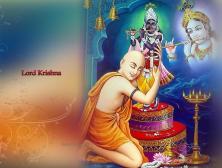 Lord Shri Krishna makes a beautiful statement about the significance of bhakti or devotion in chapter 18 of the Bhagavad-Gita as:
Lord Shri Krishna makes a beautiful statement about the significance of bhakti or devotion in chapter 18 of the Bhagavad-Gita as:
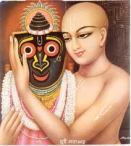 “He who neither rejoices, nor hates, nor grieves, nor desires, renouncing good and evil and who is full of devotion, is dear to Me.”
“He who neither rejoices, nor hates, nor grieves, nor desires, renouncing good and evil and who is full of devotion, is dear to Me.”
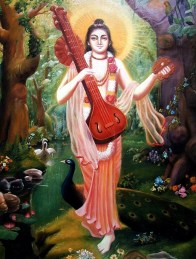 The Narada Bhakti Sutra, a discourse on the nature of bhakti based on the experiences of Sage Narada vividly describes bhakti as:
The Narada Bhakti Sutra, a discourse on the nature of bhakti based on the experiences of Sage Narada vividly describes bhakti as:
 Bhakti is not a conditional state of mind. Bhakti has no pre-conditions or pre-qualifications. There is no prescribed method or formula in bhakti. On the contrary a devotee surrenders everything unto the lord and becomes free of ego.
Bhakti is not a conditional state of mind. Bhakti has no pre-conditions or pre-qualifications. There is no prescribed method or formula in bhakti. On the contrary a devotee surrenders everything unto the lord and becomes free of ego.
 Shravanam is the first and the foremost among the nine forms of devotion. It means ‘listening’ to the divine glories of the lord pertaining to His form, qualities, leelas or divine plays, His miracles and His spoken words like the Bhagavad Gita.
Shravanam is the first and the foremost among the nine forms of devotion. It means ‘listening’ to the divine glories of the lord pertaining to His form, qualities, leelas or divine plays, His miracles and His spoken words like the Bhagavad Gita.
 Mrigari was a very cruel hearted hunter, yet sage Narada instructed him to chant the holy name of Rama. Being unable to appreciate the name of Rama, Mrigari was not able to chant.
Mrigari was a very cruel hearted hunter, yet sage Narada instructed him to chant the holy name of Rama. Being unable to appreciate the name of Rama, Mrigari was not able to chant.
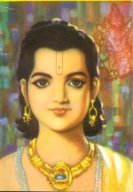 The greatest example of a devotee who realized God through smaranam is Prahlad who was just a little child at the time he attained God realization. Though Prahlad was put into many difficulties and tragedies by his atheist father Hiranyakashipu, still he constantly remembered Supreme Narayana and in the end, the Lord gave His darshan in the form of the Narasimha avatar, killing Hiranyakashipu and protecting Prahlad.
The greatest example of a devotee who realized God through smaranam is Prahlad who was just a little child at the time he attained God realization. Though Prahlad was put into many difficulties and tragedies by his atheist father Hiranyakashipu, still he constantly remembered Supreme Narayana and in the end, the Lord gave His darshan in the form of the Narasimha avatar, killing Hiranyakashipu and protecting Prahlad.
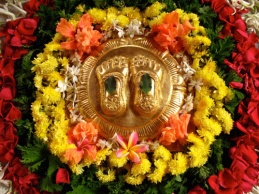 Paadasevanam is the worship of the lord by concentrating upon or ‘honouring’ His feet or Paadukaa (sanctified sandals). It is the fourth form of devotion. Paadasevanam is an innate sense of surrender to the Supreme leading to worship of the Lord’s lotus Feet. This form of intimate service to of the Lord is Paadasevanam.
Paadasevanam is the worship of the lord by concentrating upon or ‘honouring’ His feet or Paadukaa (sanctified sandals). It is the fourth form of devotion. Paadasevanam is an innate sense of surrender to the Supreme leading to worship of the Lord’s lotus Feet. This form of intimate service to of the Lord is Paadasevanam.
 “Whoever offers Me with devotion and a pure mind (heart), a leaf, a flower, a fruit or a little water—I accept this as devotion.” (Bhagavad Gita 9.26) Archanam, the fifth form of devotion, is the complete “offering” in the form of pujas or ritualistic worship, chanting mantras, singing bhajans, offering arati, food, flowers and even clothes to the Supreme. Love expresses in giving and as love for the Supreme Lord grows in the heart of the devotee, he naturally wants to offer his best. By doing this, the devotee derives inner satisfaction and inspiration.
“Whoever offers Me with devotion and a pure mind (heart), a leaf, a flower, a fruit or a little water—I accept this as devotion.” (Bhagavad Gita 9.26) Archanam, the fifth form of devotion, is the complete “offering” in the form of pujas or ritualistic worship, chanting mantras, singing bhajans, offering arati, food, flowers and even clothes to the Supreme. Love expresses in giving and as love for the Supreme Lord grows in the heart of the devotee, he naturally wants to offer his best. By doing this, the devotee derives inner satisfaction and inspiration.
 In the Skanda Purana there is a description of the result of seeing arati of the deity: ‘If someone sees the face of the Supreme while arati is going on, he can be relieved of all sinful reactions coming from all the thousands and millions of past births. He is even excused from the killing of a brahmana or similar prohibited activities.”
In the Skanda Purana there is a description of the result of seeing arati of the deity: ‘If someone sees the face of the Supreme while arati is going on, he can be relieved of all sinful reactions coming from all the thousands and millions of past births. He is even excused from the killing of a brahmana or similar prohibited activities.”
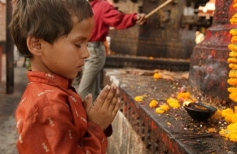 Through sincere prayers, great personalities like Akrura have realized the Supreme. Akrura’s prayers are explained in detail in Srimad Bhagavatham 10thcanto; one of which is given below: “O son of Vasudeva [Krishna], obeisance to You, within whom all living beings reside. O Supreme of the mind and senses, again I offer You my obeisance. O master, please protect me, who has surrendered unto You.”—Akrura (Srimad Bhagavatham 10.40.30)
Through sincere prayers, great personalities like Akrura have realized the Supreme. Akrura’s prayers are explained in detail in Srimad Bhagavatham 10thcanto; one of which is given below: “O son of Vasudeva [Krishna], obeisance to You, within whom all living beings reside. O Supreme of the mind and senses, again I offer You my obeisance. O master, please protect me, who has surrendered unto You.”—Akrura (Srimad Bhagavatham 10.40.30)
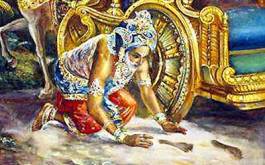 Akrura, the uncle of lord Krishna was one of the courtiers of Kamsa who was sent as a messenger to invite Krishna to Mathura to be killed. Akrura considered this as the greatest of opportunities to meet Lord Krishna and was immersed in so much longing and devotion to meet Him in Vrindavan.
Akrura, the uncle of lord Krishna was one of the courtiers of Kamsa who was sent as a messenger to invite Krishna to Mathura to be killed. Akrura considered this as the greatest of opportunities to meet Lord Krishna and was immersed in so much longing and devotion to meet Him in Vrindavan.
 The Ramayana offers an extraordinary example of personal service. Rama did not have to instruct Hanuman or offer endless encouragement; as Hanuman’s pure love for the lord itself enthralled him, when he got the opportunity to serve Rama.
The Ramayana offers an extraordinary example of personal service. Rama did not have to instruct Hanuman or offer endless encouragement; as Hanuman’s pure love for the lord itself enthralled him, when he got the opportunity to serve Rama.
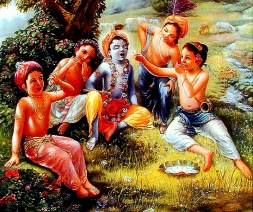 Krishna’s friends chased Him in their games, massaged His legs when He rested, and tossed sweets into His mouth while having food together. Their love for Krishna was so complete that they were blind even to His divinity and only knew how much they loved their wonderful friend.
Krishna’s friends chased Him in their games, massaged His legs when He rested, and tossed sweets into His mouth while having food together. Their love for Krishna was so complete that they were blind even to His divinity and only knew how much they loved their wonderful friend.
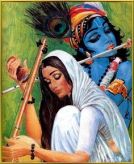 We can take up any of these paths and reach the highest state. The path of bhakti is thus the easiest and if practiced regularly , it would gradually uplift us in the progressive realization of the Supreme.
We can take up any of these paths and reach the highest state. The path of bhakti is thus the easiest and if practiced regularly , it would gradually uplift us in the progressive realization of the Supreme.
- Shravanam - Listening - example: Parkishit Maharaj, who attained liberation, by listening to the glory of Lord Krishna towards the end of His days on Earth.
- Kirtanam - Singing - example: Lord Chaitanya, who spread the worship through Sankritana of Hare Rama Hare Krishna.
- Vishnu Smaranam - Thinking of God day and night - example: Lord Hanuman, whose every hair was found to be vibrating with the name of Lord Rama.
- Pada sevanam - Servitude to the feet of the Guru/God - example: Lakshmana, whose service to His brother Sri Rama is unparalleled.
- Archanam - Adoring the beauty of God - example: Gopikas
- Vandanam - Worshipping God - example: Prahlada
- Dasyam - Having the attitude of a servant to His master.
- Sakhyam - Having the attitude of a friend toward God.
- Atma Nivedhanam - Complete self-surrender toward God. (Example: Sri Radha)
DEFINITION OF BHAKTI Bhakti is profound love for God coupled with knowledge of the majesty and magnificence of Lord Shree Krishna. - Shikshapatri Shlok 103 Narada Muni - The Acharya of Bhakti has written that Bhakti is the fifth and best ‘Purushartha’ or goal of life. It is beyond Dharma, Artha, Kama and Moksha BHAKTI There are basically two major types of Bhakti: Falaroopa - A leaf, flower, fruits or water is gladly accepted by me if offered with devotion and level of mind as explained in Gita. Sadhanroopa – This is again split into nine type known as “Navadha Bhakti” as described in Satsangi Jeevan, 1st Prakaran, 36th Adhyaay. NAVDHA BHAKTI Shravan Kirtan Smaran Archan Paadasevan Vandan Dasatva Sakha Atmanivedan SHRAVAN Is hearing of Lord's Lilas. Sravana includes hearing of God's virtues, glories, sports and stories connected with His divine Name and Form. The devotee gets absorbed in the hearing of Divine stories and his mind merges in the thought of divinity; It cannot think of undivine things. The mind loses, as it were, its charm for the world. The devotee remembers God only even in dream. The devotee should sit before a learned teacher who is a great saint and hear Divine stories. He should hear them with a sincere heart devoid of the sense of criticism or faultfinding. The devotee should try his best to live in the ideals preached in the scriptures. One cannot attain SravanaBhakti without the company of saints or wise men. Mere reading for oneself is not of much use. Doubts will crop up. They cannot be solved by oneself easily. An experienced man is necessary to instruct the devotee in the right path. King Parikshit attained Liberation through Sravana. He heard the glories of God from Suka Maharishi. His heart was purified and so attained the Abode of Lord Vishnu in Vaikuntha. He became liberated and enjoyed the Supreme Bliss. KIRTAN Is singing of Lord Glories and praises of god The devotee is thrilled with Divine Emotion. He loses himself in the love of God. He gets horripilation in the body due to extreme love for God. He weeps in the middle when thinking of the glory of God. His voice becomes choked, and he flies into a state of Divine Bhava. The devotee is ever engaged in Japa of the Lord's Name and in describing His glories to one and all. Wherever he goes he begins to sing and praise God. The devotee requests all to join his Kirtana. He sings and dances in ecstasy. He makes others also dance. In Kalyug, the way to attain moksha is kirtan bhakti Sukadeva Goswami(spoke the Bhagavatam to Maharaja Pariksit) SMARAN Is remembrance of the Lord at all times and Chanting “Swaminarayan”. This is unbroken memory of the Name and Form of the Lord. The mind does not think of any object of the world, but is ever engrossed in thinking of the glorious Lord alone. The mind meditates on what is heard about the glories of God and His virtues, Names, etc., and forgets even the body and contents itself in the remembrance of God, just as Dhruva or Prahlada did. Even Japa is only remembrance of God and comes under this category of Bhakti. Remembrance also includes hearing of stories pertaining to God at all times, talking of God, teaching to others what pertains to God, meditation on the attributes of God, etc. Remembrance has no particular time. God is to be remembered at all times without break, so long as one has got his consciousness intact. Prahlada Maharaja (never forgot Krishna despite constant tortures from his father- Hiranyakashipu) PAADSEVA Is physically serving the Lord’s feet Actually this can be done only by Lakshmi or Parvati. No mortal being has got the fortune to practice this method of Bhakti, for the Lord is not visible to the physical eyes. But it is possible to serve the image of God in idols and better still, taking the whole humanity as God. Padaseva is service of the sick. Padasevana is service of the whole humanity at large. The whole universe is only Virat-Swarupa. Service of the world is service of the Lord. Laxmi, the Goddess of Fortune, is always engaged in serving the lotus feet of the Lord. ARCHAN Is Worship of the Lord Worship can be done either through an image or a picture or even a mental form. The image should be one appealing to the mind of the worshipper. Worship can be done either with external materials or merely through an internal Bhava or strong feeling. The latter one is an advanced form of worship which only men of purified intellect can do. The purpose of worship is to please the Lord, to purify the heart through surrender of the ego and love of God. performing devotional ceremonies, e.g. aarti, applying chandan to the Lord’s forehead, mahapooja Bhagwan accepts whatever his bhaktos wants to serve Bhagwan said, when he is not present he will accept all types of artifacts to the murtis presiding in his mandirs Maharaja Prithu used all of his royal possessions in order to offer them in pure devotion to the Lord. VANDAN Is bowing, praying and prostrating before the Lord such as Sashtang Dandvat, Panchang namaskar. Humble prostration touching the earth with the eight limbs of the body (Sashtanga-Namaskara), with faith and reverence, before a form of God, or prostration to all beings knowing them to be the forms of the One God, and getting absorbed in the Divine Love of the Lord is termed prostration to God or Vandana. The ego or Ahamkara is effaced out completely through devout prayer and prostration to God. Divine grace descends upon the devotee and man becomes God. By doing vandan, you gain all the virtues of the god or person doing vandan to. Hindu culture has a tradition where you always greet a person by doing vandan to them Akrura offered prayers to Krsna when he was traveling to Vrndavana in order to see Krsna. DAASATVA Is the love of God through servant-sentiment To serve God and carry out His wishes, realizing His virtues, nature, mystery and glory, considering oneself as a slave of God, the Supreme Master, is Dasya Bhakti. Serving and worshipping the Murtis in temples, sweeping the temple premises, meditating on God and mentally serving Him like a slave, serving the saints and the sages, serving the devotees of God, serving poor and sick people who are forms of God, is also included in DasyaBhakti. To follow the words of the scriptures, to act according to the injunctions of the Vedas, considering them to be direct words of God, is Dasya Bhakti. Association with and service of love-intoxicated devotees and service of those who have knowledge of God is Dasya Bhakti. The purpose behind Dasya Bhakti is to be ever with God in order to offer service to Him and win His Divine Grace and attain thereby immortality. Hanuman, the intimate servant of Ramacandra executed all of Sri Ramacandra's orders despite all kinds of difficulties. SAKHA Is the cultivation of the friend-sentiment with God having a rapport with the Lord so that there remains a total faith in His commands and His wishes are implicitly obeyed To be always with the Lord, to treat Him as one's own dear relative or a friend belonging to one's own family, to be in His company at all times, to love Him as one's own self, is SakhyaBhava of Bhakti-Marga. The way friends, real friends, love in this world ? The amount of love they possess between one another ? Such a love is developed towards God instead of towards man; physical love turned into spiritual love. There is a transformation of the mundane into the Eternal. The inmates of the family of Nandagopa cultivated this Bhakti. Arjuna cultivated this kind of Bhakti towards Lord Krishna. Arjuna was so close to Krishna AATMANIVEDAN Is self-surrender, offering all, wealth, body and soul to the Lord The devotee offers everything to God, He keeps nothing for himself. He loses even his own self. He has no personal and independent existence. He has given up his self for God. He has become part and parcel of God. God takes care of him and God treats him as Himself. Grief and sorrow, pleasure and pain, the devotee treats as gifts sent by God and does not attach himself to them.He considers himself as a puppet of God and an instrument in the hands of God. This self-surrender is Absolute Love for God exclusively. There is nothing but God-consciousness in the devotee. Even against his own wishes, the devotee shall become one with God and lose his individuality. This is the law of being. The highest truth is Absoluteness and the soul rises above through different states of consciousness until it attains Absolute Perfection when it becomes identical with God. This is the culmination of all aspiration and love. Bali Maharaja gave Sri Vamanadeva his entire kingdom, his possessions as well as his own body CONCLUSION The nine modes of Bhakti are the ways in which a devotee attains the Supreme Ideal of life. A devotee can take up any of these paths and reach the highest state. The path of Bhakti is the easiest of all and is not very much against the nature of human inclinations. It slowly and gradually takes the individual to the Supreme without frustrating his human instincts. It is not direct assertion of God, but a progressive. By performing bhakti, one’s bad acts (paap karya) can be converted to good (punya karya) and hence can help attain Moksha.
“Navavidha Bhakti”– the 9 forms of devotion to attain the Supreme Lord
Introduction
 Lord Shri Krishna makes a beautiful statement about the significance of bhakti or devotion in chapter 18 of the Bhagavad-Gita as:
Lord Shri Krishna makes a beautiful statement about the significance of bhakti or devotion in chapter 18 of the Bhagavad-Gita as:
bhaktya maam abhijaanaati yaavaan yas chasmi
tattvataha tato maam tattvato jnaatva vishate tad-anantaram
(Bhagavad Gita 18.55)
“By devotion he knows Me in truth, what and who I am; and knowing Me in truth, he forthwith enters into the Supreme.”
In the 9th chapter Shri Krishna highlights the profoundness of true bhakti which pleases Him the most as:
patram pushpam phalam toyam yo me bhaktya prayacchati
tad aham bhakty-upahrtam asnami prayataatmanaha
(Bhagavad Gita 9.26)
“Whoever offers Me with devotion and a pure mind (heart), a leaf, a flower, a fruit or a little water—I accept this as devotion.”
Ye bhajanti tu maam bhaktyaa mayi te teshu chaapyaha
(Bhagavad Gita 9.29)
“The same am I to all beings; to Me there is none hateful or dear; but those who worship Me with devotion are in Me and I am also in them.”
Yona hrishyati na dweshti na shochati na kaangkshati
Shubhaashubhaparityaagee bhaktimaan yah sa me priyah
(Bhagavad Gita 12.17)
 “He who neither rejoices, nor hates, nor grieves, nor desires, renouncing good and evil and who is full of devotion, is dear to Me.”
“He who neither rejoices, nor hates, nor grieves, nor desires, renouncing good and evil and who is full of devotion, is dear to Me.”
Aniketah sthiramatir bhaktimaan me priyo narah
(Bhagavad Gita 12.19)
“He to whom censure and praise are equal, who is silent, content with anything, of a steady mind, and full of devotion—that man is dear to Me.”
The above slokas describe how even the tiniest of gestures in the name of devotion and love for the lord, can be a transforming experience.When God is understood and realized through the process of bhakti the person becomes realized and enters the state of self-realisation.
How do we understand true bhakti ?
 The Narada Bhakti Sutra, a discourse on the nature of bhakti based on the experiences of Sage Narada vividly describes bhakti as:
The Narada Bhakti Sutra, a discourse on the nature of bhakti based on the experiences of Sage Narada vividly describes bhakti as:
“Sa tvasmin parampremarupa” –bhakti is of the nature of perfect love for the lord devoid of any personal desires or external motives and conditions.
“Amrita swarupa cha” – bhakti is like nectar, which when one drinks, leads to the experience of ultimate bliss, which is not subject to change (Sat Chit Ananda).
“Yallabdhva puman sidhho bhavati amrito bhavati tripto bhavati” – having achieved bhakti one reaches the state of perfection, attains a God like immortality and all his desires are completely fulfilled.
“Yat praapta na kinchit vanchhati, na shochati na dveshti, narmate, notsahi bhavati”- Once bhakti is attained, one has no other desires in life as he is freed from the pairs of opposites like pleasure and pain, likes and dislikes, hence he craves for nothing else and has no other purpose to fulfil other than serving the lord and His devotees.
Through devotion a devotee transcends the worldly desires and bondages. He remains a mere instrument in the hands of God. He becomes freed from the cycle of birth and death.
How can we cultivate this true bhakti for the lord?
 Bhakti is not a conditional state of mind. Bhakti has no pre-conditions or pre-qualifications. There is no prescribed method or formula in bhakti. On the contrary a devotee surrenders everything unto the lord and becomes free of ego.
Bhakti is not a conditional state of mind. Bhakti has no pre-conditions or pre-qualifications. There is no prescribed method or formula in bhakti. On the contrary a devotee surrenders everything unto the lord and becomes free of ego.
Though bhakti is endowed as a result of God’s grace, yet it can be cultivated by us through constant practice of engaging ourselves in meaningful devotional activities that can bring us closer to the lord for His grace to flow through us.
Srimad Bhagavatham elaborates nine forms of bhakti which, if cultivated and practiced regularly will no doubt lead us closer to the lord: shravanam, kirtanam, vishnoh smaranam, paada-sevanam, archanam, vandanam, daasyam, sakhyam, aatma-nivedanam (Srimad Bhagavatham 7.5.23).
The nine forms of devotion are:
- Shravanam – Hearing the names and glories of the Lord
- Keertanam – Chanting His glories
- Smaranam – Remembering the Lord
- Paada sevanam – Serving the Lord’s feet
- Archanam – Worshiping the Lord
- Vandanam – Offering obeisance unto the Lord
- Daasyam – Serving the Lord as His servant
- Sakhyam – Developing friendship with the Lord
- Aatma Nivedanam – Total surrender of oneself to the Lord
A devotee can practice any of these nine forms of bhakti, whichever suits his nature best.  Ramakrishna Paramahansa did not serve for long as head priest of the Kali temple at Dakshineshwar. From the first days of his service in the shrine of the goddess Kali, he was filled with a rare form of the love of God known in Hinduism as maha-bhava. Worshipping in front of the statue of Mother Kali, Ramakrishna would be overwhelmed with such ecstatic love for the deity that he would fall to the ground and immersed in spiritual trance, lose all consciousness of the external world.
Ramakrishna Paramahansa did not serve for long as head priest of the Kali temple at Dakshineshwar. From the first days of his service in the shrine of the goddess Kali, he was filled with a rare form of the love of God known in Hinduism as maha-bhava. Worshipping in front of the statue of Mother Kali, Ramakrishna would be overwhelmed with such ecstatic love for the deity that he would fall to the ground and immersed in spiritual trance, lose all consciousness of the external world.
 Ramakrishna Paramahansa did not serve for long as head priest of the Kali temple at Dakshineshwar. From the first days of his service in the shrine of the goddess Kali, he was filled with a rare form of the love of God known in Hinduism as maha-bhava. Worshipping in front of the statue of Mother Kali, Ramakrishna would be overwhelmed with such ecstatic love for the deity that he would fall to the ground and immersed in spiritual trance, lose all consciousness of the external world.
Ramakrishna Paramahansa did not serve for long as head priest of the Kali temple at Dakshineshwar. From the first days of his service in the shrine of the goddess Kali, he was filled with a rare form of the love of God known in Hinduism as maha-bhava. Worshipping in front of the statue of Mother Kali, Ramakrishna would be overwhelmed with such ecstatic love for the deity that he would fall to the ground and immersed in spiritual trance, lose all consciousness of the external world.
These experiences of God-intoxication became so frequent that he was relieved of his duties as temple priest but allowed to continue living within the temple compound. During the next twelve years Ramakrishna journeyed even deeper into this passionate and absolute love for the divine. His practice was to express such intense devotion to particular deities that they would physically manifest to him and then merge into his being.
Ramakrishna attained samadhi in 1886 at the age of fifty but his life, his intense spiritual practices, and the temple of Kali where many of his ecstatic trances occurred continue to attract pilgrims from all over. Ramakrishna fully realized the infinite and all-inclusive nature of the divine. He was a conduit for divinity and the presence of that divinity can still be clearly experienced at the Kali temple of Dakshineswar.
It is said that knowledge without bhakti is useless tinsel. Let us then know the nine forms of devotion that would take us closer to the Supreme.
1. SHRAVANAM
 Shravanam is the first and the foremost among the nine forms of devotion. It means ‘listening’ to the divine glories of the lord pertaining to His form, qualities, leelas or divine plays, His miracles and His spoken words like the Bhagavad Gita.
Shravanam is the first and the foremost among the nine forms of devotion. It means ‘listening’ to the divine glories of the lord pertaining to His form, qualities, leelas or divine plays, His miracles and His spoken words like the Bhagavad Gita.
By listening to His glories, we begin to subconsciously develop love and reverence for Him.
Shravanam can be cultivated through regular satsanghs, by listening carefully to the words of the wise and that of the ancient seers and also regularly listening to the teachings of the scriptures. By hearing the stories of the lord’s divine activities, the devotee’s mind becomes purified from bad qualities like lust, anger, greed and envy. This process of transformation within the heart is described beautifully in the following five verses of Srimad Bhagavatam. This is actually the complete summary of the Bhagavata philosophy:
shrinvatam sva-kathah krishnah punya-shravana-kirtanah hridy antah-stho hy abhadrani vidhunoti suhrit satam (Srimad Bhagavatham 1.2.17)
nashta-prayeshv abhadreshu nityam bhagavata-sevaya bhagavaty uttama-shloke bhaktir bhavati naishthiki (Srimad Bhagavatham 1.2.18)
tada rajas-tamo-bhavah kama-lobhadayas ca ye ceta etair anaviddham sthitam sattve prasidati (Srimad Bhagavatham 1.2.19)
evam prasanna-manaso bhagavad-bhakti-yogatah bhagavat-tattva-vijnanam mukta-sangasya jayate (Srimad Bhagavatham 1.2.20)
bhidyate hridaya-granthish chidyante sarva-samshayah kshiyante casya karmani drishta evatmanishvare (Srimad Bhagavatham 1.2.21)
“To hear about lord Krishna from the vedic literatures, or to hear from Him directly through the Bhagavad Gita is itself an auspicious and righteous activity. Such an ardent devotee, who keeps himself constantly engaged in hearing about the lord is blessed and purified by the Him, who is dwelling in his heart.
By cultivation of devotional service he is relieved from the modes of passion (rajas) and ignorance (tamas), and thus material lusts and avarice diminish. When these impurities are wiped away, the devotee remains steady in his position of pure goodness (sattva), becomes enlivened by devotional service and understands the science of God perfectly.
Thus bhakti-yoga severs the hard knot of material bondage and enables one to attain the state of ‘asamshayam-samagram,’ which means the total understanding and realization of the Supreme.”

The story of King Parikshit given in Srimad Bhagavatham is an example of a devotee who exemplified shravanam. Due to a curse Parikshit had only a week to live, but he attained salvation by listening to the glories of Krishna in the form of Srimad Bhagavatham narrated by Sage Suka in the forests of Naimisharanya.
To cultivate shravanam three qualities are needed – an yearning to listen, listening with total faith and putting into practice what has been listened to. The act of listening itself becomes worship of the lord and the process of shravanam becomes effective as a form of devotion, leading us to liberation.
2. KEERTANAM
Keertanam is the second form of devotion which involves ‘singing’ the praise of the lord’s magnificence and omniscience with heartfelt devotion.
By constantly chanting the lord’s name, devotees like Dhruva, Draupadi, Prahalad, Meera, Chaitanya Maha Prabhu and Tukaram have achieved God realization. Chanting God’s name brings relief to the devotee’s mind.
It is said that Keertanam is the only way to achieve salvation in this kali yuga.
Given below is a short selection of verses taken from the different vedic literatures glorifying the significance of chanting the holy names of the lord.
bhagavata adi purushasya narayanasya namoccharana matrena nirdhta kalir bhavati [Kali santarana Upanishad verse 3]
“Simply by chanting the transcendental names of the lord Narayana, all the sins will be cleansed in Kali-yuga.” hare krishna hare krishna, krishna krishna hare hare hare rama hare rama, rama rama hare hare [Kali santarana Upanishad verse 5] iti shodashakam namnam, kali-kalmasha-nashanam natah parataropayah, sarva-vedeshu drishyate [Kali santarana Upanishad verse 6]
“The sixteen words-Hare Krishna, Hare Krishna, Krishna Krishna, Hare Hare; Hare Rama, Hare Rama, Rama Rama, Hare Hare – are especially meant for completely destroying all the contamination of Kali yuga. To save oneself from the evil effects of Kali-yuga, there is no other alternative that can be found in the entire vedas except the chanting of this Hare Krishna mahaa mantra.” harer nama harer nama, harer namaiva kevalam kalau nasty eva nasty eva, nasty eva gatir anyatha (Brihan-naradiya Purana, 38.126)
“In this age of quarrel and hypocrisy the only means of deliverance is chanting the holy names of the Supreme. There is no other way. There is no other way. There is no other way.” Sage Narada is the supreme example of one who realised the divine by continuously singing the glories of God in all circumstances and at all times. He also demonstrated to the world the supreme spiritual efficacy of singing the lord’s glories. One good example from our scriptures through which sage Narada explained the significance of Keertanam is that of the story of Mrigari.
 Mrigari was a very cruel hearted hunter, yet sage Narada instructed him to chant the holy name of Rama. Being unable to appreciate the name of Rama, Mrigari was not able to chant.
Mrigari was a very cruel hearted hunter, yet sage Narada instructed him to chant the holy name of Rama. Being unable to appreciate the name of Rama, Mrigari was not able to chant.
Seeing this, Narada told him to chant the word “mara” instead, meaning “death”. Mrigari was an expert at killing animals, and he especially enjoyed half killing the animals to watch them suffer to death. So when Narada told him to chant “death” (mara), Mrigari found it very easy and natural. He sat and started chanting the word – mara, mara, mara, over and over again.
When he kept doing this, the gap between the words disappeared and instead of chanting “mara“, he was actually chanting “rama“. The name of Sri Rama is so powerful that it developed love of God even in the heart of the cruel hunter Mrigari. He did not know he was chanting the name of Supreme Rama, whose name even accidentally chanted once, would purify the heart.
This very same Mrigari, by chanting continuously the name of Sri Rama, transformed into the great sage Valmiki. Such is the amazing power of chanting the lord’s name. It is not amazing that, by chanting His name, personalities like sage Valmiki have become purified and attained perfection.
3. SMARANAM
Smaranam is the constant ‘remembrance’ of the lord, reveling in the contemplation of His beauty, majesty and compassion. It is the third form of devotion. In the Narasimha Purana there is a statement about meditation on the form of the Supreme:
Bhagavath charana dwandwa dhyaanam nirdwandwamiritam, paapinopi prasangena vihitam suhitam param (Taken from excerpts of Bhaktirasaamrita sindu by Shri Rupa Goswami, sloka 179)
“Meditation focusing on the Lotus feet of the Supreme is transcendental and beyond the experience of material pain and pleasure. By such meditation, even one who is sinful can be delivered from all the sins he has committed in his life.”
In the holy book of Vishnudharma there is a statement about remembering the personal traits and qualities of the Supreme :
Ye kurvanti sadaa bhaktya gunaanusmaranam hare: Praksheena kalushoughaaste pravishanti hare: padam (Taken from excerpts of Bhaktirasaamrita sindu by Shri Rupa Goswami, sloka 180)
“Those who always contemplate on the qualities of the Supreme with devotion are freed from all impurities and enter Supreme Hari’s abode.”
In the Padma Purana there is a statement about remembering the activities of the lord:
Sarva maadhurya saaraani sarvaadbhuta mayaani cha dhyaayan harescharitraani lalithaani vimuchyate (Taken from excerpts of Bhaktirasaamrita sindu by Shri Rupa Goswami, sloka 181)
“A person who is always engaged in meditation on the leelas and the wonderful activities of the Supreme surely becomes freed from all material contamination.”
 The greatest example of a devotee who realized God through smaranam is Prahlad who was just a little child at the time he attained God realization. Though Prahlad was put into many difficulties and tragedies by his atheist father Hiranyakashipu, still he constantly remembered Supreme Narayana and in the end, the Lord gave His darshan in the form of the Narasimha avatar, killing Hiranyakashipu and protecting Prahlad.
The greatest example of a devotee who realized God through smaranam is Prahlad who was just a little child at the time he attained God realization. Though Prahlad was put into many difficulties and tragedies by his atheist father Hiranyakashipu, still he constantly remembered Supreme Narayana and in the end, the Lord gave His darshan in the form of the Narasimha avatar, killing Hiranyakashipu and protecting Prahlad.
Thus even in all the extreme sufferings and pain, Prahlad kept remembering the Supreme and never lost his faith in the lord. From this we understand that a true and pure devotee who constantly remembers the Lord in all situations is never unhappy in any situation of life. This is confirmed in Srimad-Bhagavatam in the following sloka:
narayana-parah sarve na kutascana bibhyati svargapavarga-narakesv api tulyartha-darsinah (Srimad Bhagavatham 6.17.28)
“Devotees solely engaged in the devotional service of lord Narayana, never fear any condition of life. For them the heavenly planets, liberation and the hellish planets are all the same, for such devotees are interested only in the service of the lord.”
4. PAADASEVANAM
 Paadasevanam is the worship of the lord by concentrating upon or ‘honouring’ His feet or Paadukaa (sanctified sandals). It is the fourth form of devotion. Paadasevanam is an innate sense of surrender to the Supreme leading to worship of the Lord’s lotus Feet. This form of intimate service to of the Lord is Paadasevanam.
Paadasevanam is the worship of the lord by concentrating upon or ‘honouring’ His feet or Paadukaa (sanctified sandals). It is the fourth form of devotion. Paadasevanam is an innate sense of surrender to the Supreme leading to worship of the Lord’s lotus Feet. This form of intimate service to of the Lord is Paadasevanam.
But what is the significance of worshipping the Lord’s feet?
To approach a person’s feet is a sign of humility and that is why in Indian tradition, we are taught to touch our parent’s and elder’s feet as a token of respect. The feet of the Supreme Lord are so sweet and beautiful that they are known as paada pankajam or Lotus feet as they are so soft and red like the lotus petals.
Simply thinking of the Lord’s feet takes devotees to deep feelings of love, longing and ecstasy. Even the mighty devas were delighted when little Krishna wandered the forests of Vrindavan, leaving His footprints in the dust. And Krishna’s dear friends the gopis would press this dust against their heads and hearts, lost in ecstatic trance.
Srimad Bhagavatham (10.38.30) describes the Lord’s beautiful feet in detail- “The two great personalities, Krishna and Balarama, had both made the land of Vraja extremely beautiful by decorating it with Their footprints, which had many auspicious markings, such as the flag, thunderbolt, rod for controlling elephants, and Lotus flower”.
On Krishna’s feet there are 19 symbols of Narayana or Vishnu. On His right foot are a Lotus, flag, chakra, umbrella, four swastikas, uddhava rekha (upcurving line), barley corn, elephant goad, ashtakon (octagon), four blackberry fruits, and vajra. On His left foot are four water pots, a conch, an unstrung bow, cow’s hoof, fish, crescent moon, akash (sky), and a triangle. 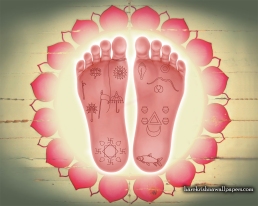 The Skanda Purana states the particular places on His feet where Krishna carries the mark of the flag and also other marks, and the reasons for these marks:
The Skanda Purana states the particular places on His feet where Krishna carries the mark of the flag and also other marks, and the reasons for these marks:
 The Skanda Purana states the particular places on His feet where Krishna carries the mark of the flag and also other marks, and the reasons for these marks:
The Skanda Purana states the particular places on His feet where Krishna carries the mark of the flag and also other marks, and the reasons for these marks:
‘At the base of the large toe on His right foot, the unborn Supreme carries the mark of a disc, which cuts down the six (mental) enemies of His devotees.
At the bottom of the middle toe of that same foot, Supreme Achyuta has a Lotus flower, which increases the greed for Him in the minds of the beelike devotees who meditate on His feet. At the base of His small toe is a thunderbolt, which smashes the mountains of His devotees’ reactions to past sins, and in the middle of His heel is the mark of an elephant goad, which brings the elephants of His devotees’ minds under control. The joint of His right large toe bears the mark of a barleycorn, representing all kinds of enjoyable opulence.’
Thus worshipping the Supreme’s Lotus feet by itself is a great spiritual blessing, because anyone charmed by those transcendental feet loses attraction to pursuits of short lived pleasures in life. Brahma explains the significance of Paadasevanam in Srimad Bhagavatham as –
“For one who has accepted the boat of the Lotus feet of the Supreme, who is the shelter of the cosmic manifestation and is famous as Murari (the enemy of the demon Mura), for him the ocean of the material world is like the water contained in a calf’s hoof print. His goal is parama padam, or Vaikunta, the place where there are no material miseries, not the samsara; not the place where there is danger at every step.” (Srimad-Bhagavatam 10.14.58).
One of the beautiful examples of bhakti extolled in Paadasevanam is none other than Goddess Lakshmi Herself, the consort of Supreme Vishnu. Goddess Lakshmi is always seen massaging the Lotus feet of the Supreme. This is remarkable, as noted in Srimad-Bhagavatam (1.11.33): “The goddess of fortune, although by nature very restless and moving, could not quit the Supreme’s feet.”
This is remarkable, as noted in Srimad-Bhagavatam (1.11.33): “The goddess of fortune, although by nature very restless and moving, could not quit the Supreme’s feet.”
 This is remarkable, as noted in Srimad-Bhagavatam (1.11.33): “The goddess of fortune, although by nature very restless and moving, could not quit the Supreme’s feet.”
This is remarkable, as noted in Srimad-Bhagavatam (1.11.33): “The goddess of fortune, although by nature very restless and moving, could not quit the Supreme’s feet.”
Goddess Lakshmi is often restless in nature in the form of wealth and good fortune; both of which are elusive and temporary. Mortals cannot control Goddess Lakshmi, although many waste their lives trying. As a devoted servant of the Supreme, the Goddess of fortune bestows her bounty only with the Supreme’s blessings.
Thus pada-sevanam offers a deep spiritual lesson. Though Lakshmi is the Goddess of wealth and presides over all forms of prosperity, she shows to the world that serving the Supreme’s feet is greater than all the treasures on earth. In present times, we often worship Shri (wealth) more than Hari (the Supreme). What we do not realize is that by worshipping the Supreme’s feet, even wealth is achieved automatically. What foolishness is it to go after money, forgetting the Lotus feet of the Supreme, which are the fountain source of all prosperity!
5. ARCHANAM
 “Whoever offers Me with devotion and a pure mind (heart), a leaf, a flower, a fruit or a little water—I accept this as devotion.” (Bhagavad Gita 9.26) Archanam, the fifth form of devotion, is the complete “offering” in the form of pujas or ritualistic worship, chanting mantras, singing bhajans, offering arati, food, flowers and even clothes to the Supreme. Love expresses in giving and as love for the Supreme Lord grows in the heart of the devotee, he naturally wants to offer his best. By doing this, the devotee derives inner satisfaction and inspiration.
“Whoever offers Me with devotion and a pure mind (heart), a leaf, a flower, a fruit or a little water—I accept this as devotion.” (Bhagavad Gita 9.26) Archanam, the fifth form of devotion, is the complete “offering” in the form of pujas or ritualistic worship, chanting mantras, singing bhajans, offering arati, food, flowers and even clothes to the Supreme. Love expresses in giving and as love for the Supreme Lord grows in the heart of the devotee, he naturally wants to offer his best. By doing this, the devotee derives inner satisfaction and inspiration.
Vedic scriptures prescribe worship of the deity as a means to develop a relationship with the God as a person. While it is true that God is paramatma it is also true that, as the paramatma, He permeates all matter and is present in every atom be it living or non living. God cannot be separated from His creation, and so to worship His form, even if constructed of physical materials, is certainly to worship Him. Thus scriptures mention a variety of materials that may be used to create the deity, including earth, sand, and even the mind.
Yo yo yaam yaam tanum bhaktah shraddhayaarchitum icchati
Tasya tasyaachalaam shraddhaam taameva vidadhaamyaham
Whatsoever form any devotee desires to worship with faith—that (same) faith of his I make firm and unflinching. (Bhagavad Gita Chapter 7. 21).
There is only one God, yet He manifests in many different forms. As the Supreme, He enjoys relationships with all living beings; each relationship is intimate and unique. In His form as Supreme Rama, He enjoyed the role of a king and as a faithful husband to Mother Sita. In His form as Supreme Narasimha, He was the ferocious protector of His true devotee Prahalad. In His form as baby Krishna, He was playful and mischievous. All of these roles are manifestations of the same Supreme Personality, and thus all these divine avatars of the Supreme may be worshiped in a deity form.
Although each of these various forms of God is supreme, a devotee may feel a stronger attraction for a particular deity. Hence one can perform archanam to all the deities or to a particular deity personally preferred as the istha devata. Thus archanam can be done in a temple or also in one’s personal altar at home or sometimes even manasa pooja can be done at the mind level. Archanam or deity worship combines an external ritual with internal meditation. We can do archanam by offering flowers to the lord, chanting His holy names like the Sahasranamas or the Ashtotarams.  Arati is one aspect of archanam.
Arati is one aspect of archanam.
 Arati is one aspect of archanam.
Arati is one aspect of archanam.
In most of the temples after the ritualistic worship of the deity with flowers and other offerings, the sanctum doors are closed during alankaram or dressing up and neivedhyam or feeding of the lord. During arati, auspicious items like incense, a flame (ghee lamp), a conch shell with water, a cloth, flowers, a chamara (yak-tail fan), and a peacock fan are waved before the deity to offer protection by dispelling inauspicious influences.
 In the Skanda Purana there is a description of the result of seeing arati of the deity: ‘If someone sees the face of the Supreme while arati is going on, he can be relieved of all sinful reactions coming from all the thousands and millions of past births. He is even excused from the killing of a brahmana or similar prohibited activities.”
In the Skanda Purana there is a description of the result of seeing arati of the deity: ‘If someone sees the face of the Supreme while arati is going on, he can be relieved of all sinful reactions coming from all the thousands and millions of past births. He is even excused from the killing of a brahmana or similar prohibited activities.”
This explains the importance of regularly visiting temples for prayers and worshipping the Lord and witnessing the arati in the form of archanam. In this form of worship, Prithu demonstrated the unique significance of Angaarchana or using each of his sense organs in worshipping the Supreme. “Netra kamalam samarpayami” (I offer my Lotus eyes to the Supreme). “Srotra kamalam samarpayami” (I offer the Lotus ears to the Supreme)”. “Hridaya kamalam samarpayami” (I offer the Lotus of my heart to the Supreme): in this manner Prithu regarded every organ of his body as the Lotus to be offered to the Supreme Lord in worship. One of the most wonderful aspects of archanam is that it employs all the four forms of devotional service discussed so far i.e hearing about the Lord, chanting His names, remembering Him, and serving His Lotus feet. Thus it is a very significant form of devotion that can be practiced as a routine in our daily life to seek God’s grace.
6. VANDANAM
Vandanam is supreme ‘reverence’ or ‘prayer’ to the lord and is the sixth form of devotion. In this form of devotion a devotee begins to see his favorite form of the Lord everywhere and in all beings and objects.
Vandanam is an intensely personal process and it may also be the most universal form of bhakti, through universal prayers that make up the traditions of the different religions and cultures of the world, creating our most ancient ties and our most common language- the language of a sincere prayer to the Supreme.
There are various forms of prayers – simple prayers of gratitude, prayers for the welfare of loved ones, prayers for speedy recovery of ill health and of course, prayers for some coveted desires to be fulfilled.
Chaturvidhaa bhajante maam janaah sukritino’rjuna Aarto jijnaasurartharthee jnaanee cha bharatarshabh Teshaam jnaanee nityayukta eka bhaktirvishishyate Priyo hi jnaanino’tyarthamaham sa cha mama priyah (Bhagavad Gita chapter 7.16,7.17)
“Four kinds of virtuous men worship Me, O Arjuna! They are the distressed, the seeker of knowledge, the seeker of wealth, and the wise, O lord of the Bharatas! Of them, the wise, ever steadfast and devoted to the One, excels (is the best); for, I am exceedingly dear to the wise and he is dear to Me.”
 Through sincere prayers, great personalities like Akrura have realized the Supreme. Akrura’s prayers are explained in detail in Srimad Bhagavatham 10thcanto; one of which is given below: “O son of Vasudeva [Krishna], obeisance to You, within whom all living beings reside. O Supreme of the mind and senses, again I offer You my obeisance. O master, please protect me, who has surrendered unto You.”—Akrura (Srimad Bhagavatham 10.40.30)
Through sincere prayers, great personalities like Akrura have realized the Supreme. Akrura’s prayers are explained in detail in Srimad Bhagavatham 10thcanto; one of which is given below: “O son of Vasudeva [Krishna], obeisance to You, within whom all living beings reside. O Supreme of the mind and senses, again I offer You my obeisance. O master, please protect me, who has surrendered unto You.”—Akrura (Srimad Bhagavatham 10.40.30) Akrura, the uncle of lord Krishna was one of the courtiers of Kamsa who was sent as a messenger to invite Krishna to Mathura to be killed. Akrura considered this as the greatest of opportunities to meet Lord Krishna and was immersed in so much longing and devotion to meet Him in Vrindavan.
Akrura, the uncle of lord Krishna was one of the courtiers of Kamsa who was sent as a messenger to invite Krishna to Mathura to be killed. Akrura considered this as the greatest of opportunities to meet Lord Krishna and was immersed in so much longing and devotion to meet Him in Vrindavan.
As soon as he reached Vrindavan, when he saw the Lord’s footprints, he immediately jumped down from his chariot and saluted the sacred soil. His heart was filled with deep satisfaction even to see the footprints and prayed sincerely to the Lord, free from all kinds of fear and grief that was instigated by Kamsa. Thus he attained the lord through this form of devotion – vandanam.

Another great example is that of queen Kunti in the Mahabharata. Her prayer to Lord Krishna was: namasye purusham tvadyam ishwaram prakriteh param alakshyam sarva bhutanam antar bahir avasthitam ( Srimad Bhagavatham 1.8.18)
“O Krishna, I offer my obeisance unto You because You are the original personality and are unaffected by the qualities of the material world. You are existing both within and without everything, yet You are invisible to all.” The Pandavas and queen Kunti were fortunate to be associated with Lord Krishna, who helped them endure death and separation of loved ones, financial ruin, and even humiliation.
After the Kurukshetra war, when finally the trials of the Pandavas came to an end, Krishna prepared to leave. Kunti prayed to Him thus: “Oh Krishna let our sufferings come again, for when we see them, we see You, and then our birth and death are through.” Later she prayed, “Please cut the ropes of my attachment to my family so my love can flow to You alone, like the Ganges to the sea”. Most of us would be reluctant to offer such prayers, but not the fearless Queen Kunti!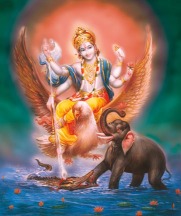

The significance of this form of devotion is that it is not just for humans to practice, but even animals and other beings can offer this form of devotion to attain the Lord. The best example of an animal that attained the Lord through vandanam is Gajendra, the elephant king who, once, while bathing in a river was suddenly encountered by a ferocious crocodile. The crocodile caught Gajendra’s leg in his mighty jaws, and despite Gajendra’s own massive power and the assistance of his elephant herd, he was unable to free himself. As Gajendra saw his death approaching, he realized that no one could truly save him except the Supreme. From deep within the elephant’s being arose the words to a prayer learnt in a former life, and he sang it out with devotion. Moved by the pure-hearted song of surrender, Krishna appeared and killed the crocodile and Gajendra attained moksha.
Thus prayer is a reflection of our spiritual realization and our unique relationship with God. Prayer is everything from our most intimate conversations with the lord in our hearts to the universal expressions of praise and gratitude echoing through time. It is not a language of words, but a language of heart. Beautiful prayers uttered with no feelings mean nothing to the Supreme. The beauty of a prayer, however articulated, lies in its sincerity.
7. DAASYAM
Daasyam is the seventh form of devotion where the devotee sees himself as not just the ‘servant’ of the Lord but also the servant of the Lord’s devotees, with no sense of inferiority. Daasyam refers to a heartfelt yearning to be of personal service to the Supreme. It is the ultimate expression of humility, yet it is bold in its aspiration to such a lofty position.
To attain daasyam one must completely understand that God is a person. He is not our creation. Rather, He is a person of such wonder and magnitude that this vast, imponderable world is just a tiny spark of His creative ability.
To serve Him we must come to know this magnificent person and understand His desires. And while He kindly recognizes all attempts at service, the self-centered cannot attain the intimate experience of true service to the Supreme. Service to God is so intimate that He offers it only to the most trustworthy souls.
 The Ramayana offers an extraordinary example of personal service. Rama did not have to instruct Hanuman or offer endless encouragement; as Hanuman’s pure love for the lord itself enthralled him, when he got the opportunity to serve Rama.
The Ramayana offers an extraordinary example of personal service. Rama did not have to instruct Hanuman or offer endless encouragement; as Hanuman’s pure love for the lord itself enthralled him, when he got the opportunity to serve Rama.
During his search for Sita, Hanuman was captured and ill-treated by Ravana. Yet Hanuman’s desire to serve Rama remained unchanged. Hanuman prayed to Rama with no expectations whatsoever, but prayed only for His blessings to be with him forever.
He prayed to Rama asking: “My dear Lord, if You like You can give me salvation from this material existence, or the privilege of merging into Your existence, but I do not wish any of those things. I do not wish anything which diminishes my relationship with You as servant to master, even after liberation.”
Thus Hanuman is the supreme example of daasya bhaktha or the one who realized God through serving Him wholeheartedly.
So for us, daasyam means not only to serve the lord directly, but to serve even those who serve Him. Our aspiration should rather be to serve the servants of the servants of the servants of the lord, stretching our humility as far as our realizations will allow. It is said that the servants or the devotees of the Lord are even kinder than the Lord Himself. That’s one reason we need a guru to attain daasyam. True humility thus naturally appears in a true guru, whose heart is ever-satisfied as the servant of Lord’s servants.
8. SAKHYAM
Sakhyam is the eighth form of devotion wherein the devotee considers himself to be the ‘friend’ or sakhaa of the Supreme. Just like the body that we see and feel around us is temporary and fickle, so is this material world. But there is another world, composed exclusively of spiritual energy, in which everything is sentient and full of love for the Supreme -for example Vrindavan where Krishna enjoyed His childhood. Even the blades of grass there have a vibrant relationship with the lord, who spent His days taking care of His cows and playing with His friends. Think of those friendships!
 Krishna’s friends chased Him in their games, massaged His legs when He rested, and tossed sweets into His mouth while having food together. Their love for Krishna was so complete that they were blind even to His divinity and only knew how much they loved their wonderful friend.
Krishna’s friends chased Him in their games, massaged His legs when He rested, and tossed sweets into His mouth while having food together. Their love for Krishna was so complete that they were blind even to His divinity and only knew how much they loved their wonderful friend.
Who else can be our best friend other than the Supreme? 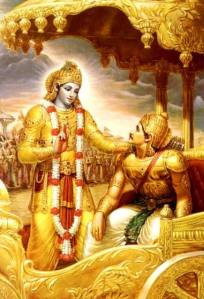 Arjuna is another classic example of a devotee who achieved perfection through friendship with the lord.
Arjuna is another classic example of a devotee who achieved perfection through friendship with the lord.
 Arjuna is another classic example of a devotee who achieved perfection through friendship with the lord.
Arjuna is another classic example of a devotee who achieved perfection through friendship with the lord.
Krishna was so familiar to Arjuna that he even asked Krishna to drive his chariot in the battle of Kurukshetra! And yet, when Arjuna became confused as he faced his relatives on the battlefield, he turned to his friend and charioteer for help. Because Arjuna had such a friendly rapport with the lord, his turning to Krishna for instruction was a shift in the relationship.
When Krishna reveals His magnificent universal form to His friend Arjuna, he was aghast, and stammered out an apology. “I have in the past addressed You as ‘O Krishna,’ ‘O Yadava,’ ‘O my friend,’ without knowing Your glories. Please forgive whatever I may have done in madness or in love.” (Bhagavad Gita. Chapter 11.41)
Krishna is so kind and merciful that in spite of such opulence He played with Arjuna as a friend. Such is the transcendental loving reciprocation between the devotee and the lord.
Although Arjuna had seen the opulence in Krishna’s universal form, he could not forget the friendly relationship with Him. This is the beauty of having an eternal friendship with the Lord!
Completely pure souls in the spiritual world enjoy a friendship with the lord because they have no desire for anything else. In the text Madhurashtakam it is stated –how sweet is lord’s friendship with us – “sakhyam madhuram”! Recognizing that the lord has already extended Himself to us, it is left to us to reciprocate His friendship.
9. AATMANIVEDANAM
Aatmanivedanam is the ninth form of devotion which means yielding fully or the ‘complete surrender’ to the will of the Supreme, with no traces of ego whatsoever left in the devotee’s heart. Completely filled with devotion to God, the devotee gains the knowledge of his true self in this form of devotion where the devotee and the lord become one.
In the Narsimha Purana, lord Narasimha says, “Anyone who prays unto Me and takes shelter from Me becomes My ward, and I protect him always from all sorts of calamities.”
The same is stated in the Bhagavad Gita by Krishna as:
Ananyaaschinta yanto maam ye janaa paryupaasate teshaam nityaabhiyuktaanaam yoga kshemam vahaamyaham (Bhagavad Gita,9.22) “He who constantly remembers me and worships me at all times, is protected and his welfare is taken care of by Me at all times.” King Bali is the perfect example of Atmanivedanam or complete self-surrender unto the lord.
Ananyaaschinta yanto maam ye janaa paryupaasate teshaam nityaabhiyuktaanaam yoga kshemam vahaamyaham (Bhagavad Gita,9.22) “He who constantly remembers me and worships me at all times, is protected and his welfare is taken care of by Me at all times.” King Bali is the perfect example of Atmanivedanam or complete self-surrender unto the lord.
In Vamana avatar of Lord Vishnu, King Bali welcomed the Lord disguised as a young Brahmin with open arms and promised him that he would offer him whatever he desired. He offered to wash the feet of Vamana and sanctify himself by sprinkling that water on his own head. Bali’s preceptor, Sukracharya was an all-knowing counselor. Aware that Vamana was an incarnation of Vishnu, he advised Bali to go back on his offer to Vamana.
But Bali’s magnanimity and greatness may be seen in the fact that he refused to accept his preceptor’s advice. Bali said, “When the Supreme lord Himself has come to me with out-stretched hands asking for a gift, what greater good fortune I can have than making the gift from my humble hands? I am prepared to give away everything regardless of what happens to me.”
Bali told Lord Vishnu: “I offer to you, Oh lord, all my wealth and possessions, as well as myself. I take refuge in you, protect me, Oh lord.” (Srimad Bhagavatham 8th canto). This was the sense of abnegation with which Bali offered himself to Lord Vamana. Thus he attained the lord through his selfless devotion and surrender to the Supreme.
In other words, we should learn how to cry for the lord in tears of bhakti. This is called laulyam, and such tears are the price for the highest perfection.
This feeling of ‘oneness’ with the lord and all His divine beings is achieved only in the spirit of the final form of devotion to the Supreme–aatmanivedanam.
Conclusion
When cattle try to devour a newly planted sapling, the plant struggles to live and grows more leaves. But surpassing these struggles, when the plant grows into a tree, then the cattle is no longer a threat to the tree. Likewise, when our devotion is in its initial stages, the ill effects of the material world affect us to a great extent. But when we continue to involve ourselves in various forms of bhakti, with patience and perseverance, we soon become strong enough and the ill effects of the material world do not affect us anymore.
We gradually attain the states of Saalokya, Saaroopya, Saameepya and Saayujya.  When we worship the lord, we attain the world/plane (loka) of that deity. This is called ‘Saalokya’.
When we worship the lord, we attain the world/plane (loka) of that deity. This is called ‘Saalokya’.
 When we worship the lord, we attain the world/plane (loka) of that deity. This is called ‘Saalokya’.
When we worship the lord, we attain the world/plane (loka) of that deity. This is called ‘Saalokya’.
We then attain ‘Saaroopya’ or the form of that deity like Krishna’s dear friend Uddhava who had the exact form of Krishna due to his devotion.
Then, we attain ‘Saameepya’ or the proximity to that deity. Finally, we become one with that deity which is known as ‘Saayujya’.
Practically speaking, what it means is that when we do incessant chanting of the lord’s name in the same place, divinity is created in that place around us.
Bhakti is bliss and more blissful would be our lives when we cultivate and practice the above discussed navavidha bhakti or nine forms of devotion in our journey of life towards the Supreme.
 We can take up any of these paths and reach the highest state. The path of bhakti is thus the easiest and if practiced regularly , it would gradually uplift us in the progressive realization of the Supreme.
We can take up any of these paths and reach the highest state. The path of bhakti is thus the easiest and if practiced regularly , it would gradually uplift us in the progressive realization of the Supreme.
Let us keep remembering and chanting the names of the lord at all times! Let our hearts bloom into beautiful flowers of divinity, by drinking the daily dosage of the divine nectar of eternal bhakti!
Jai Shree Krishna! Hari Om!
| Path of Devotion | Best example |
|---|---|
| 1) Through Hearing about God | King Parikshit |
| 2) Through Chanting of Devotional songs | Devarshi Narada |
| 3) Through Remembrane of the Lord | Prahlad |
| 4) Through Attending to Lord's feet | Godess Lakshmi |
| 5) Through Worship and offering | King Prithu |
| 6) Through Singing in Praise of the Lord | Boliraj |
| 7) Through Service to Lord | Lord Hanuman, through his service to Lord Rama |
| 8) Through Divine friendship | Arjuna, through his friendship to Lord Krishna |
| 9) Through self surrender to the Lord | Karna |
| 10) Through Meditation and concentration | Lord Mahadeva |
| 11) Through Love and longing | Radha, through her longing for Lord Krishna |





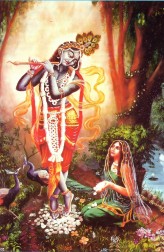
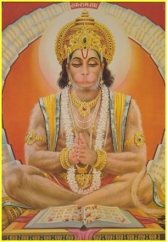


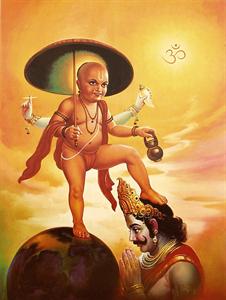
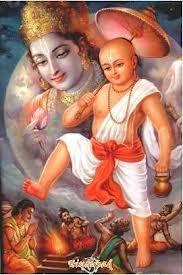
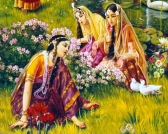
கருத்துகள் இல்லை:
கருத்துரையிடுக